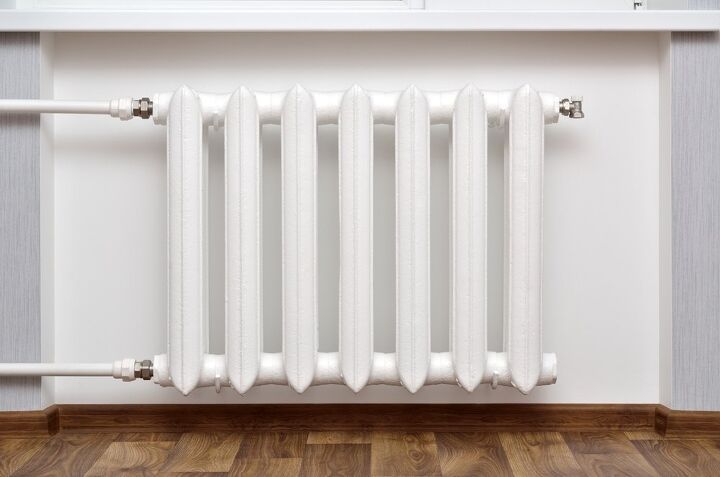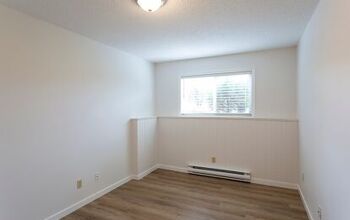Cast Iron Vs. Baseboard Radiators: Which One Is Better?

An important part of owning a home is maintaining comfortable temperatures through heating and air conditioning. During the colder months, one way to keep your home warm and cozy is to install a radiator. But with so many different types of radiators available, how do you know which is the best fit for you?
Cast iron radiators and baseboard radiators are two options for heating your home that provide even heat dispersal. Both can be expected to work for decades, but cast iron radiators are more efficient and less expensive. Baseboard radiators, however, come with high operation costs and must be cleaned by a professional on a regular basis.
Do You Need a Heating and Cooling Contractor?
Get free, zero-commitment quotes from pro contractors near you.

Cast Iron Radiators
How Do Cast Iron Radiators Work?
Cast iron radiators were invented back in the mid-1800s. They work by boiling water to create steam. The steam then travels through pipes into the cast iron radiator, which uses radiation and convection to heat the room.
Once the steam has traveled through the unit, it cools and turns into condensation. The condensation moves through the unit, ending up back in the boiler to be turned into steam again.
The main function of cast iron radiators is to increase the mean radiant temperature in the room. Radiant energy originating from the radiator travels through the air without heating it until it reaches a solid surface. Once the object is warmed, it warms the surrounding air as well.
Pros of Cast Iron Radiators
There are plenty of advantages that come with cast iron radiators. First, they’re extremely efficient and retain heat well. Even after they’re turned off, cast iron radiators hold their heat for a long period of time.
SafetyAnother benefit of cast iron radiators is that they’re considered very safe in comparison to other types of heaters. They’re less of a fire hazard than other types of heaters, such as space heaters. Plus, cast iron radiators are typically anchored to the wall for added safety and stability.
Low-MaintenanceCast iron radiators require very little maintenance, considering they have no fuels to replace. They’re also thick, solid, and very reliable, typically lasting for decades at a time before they need to be replaced.
Other Benefits of Cast Iron RadiatorsAlthough steam radiators tend to be a bit noisy, cast iron radiators are the quietest type of steam radiator. They provide even heat, so you won’t have any hot or cold spots in your home. Plus, cast iron radiators are stylish and elegant, and they look especially nice in vintage-style houses.
Cons of Cast Iron Radiators
Of course, cast iron radiators aren’t without their drawbacks. Notably, they take up a large amount of space and require proper airflow to run safely and efficiently. They can be noisy at times, although they’re not as loud as other types of steam radiators.
Cast iron radiators aren’t ideal for smaller rooms, and they’re very heavy, so they can’t be mounted on walls. One thing to remember is that cast iron radiators can be hot to the touch. This makes them a little less convenient for homes with children and pets.
Baseboard Radiators
How Do Baseboard Radiators Work?
Baseboard radiators have two sections that use convection in order to heat the room. The process starts with a coil of copper pipes, which carry hot water. Then, aluminum fins attached to the coil transfer the heat from the water into the surrounding air.
At the same time, the bottom of the radiator pulls in the cold air from the room. This cold air is then heated by the fins, and the process continues.
Baseboard radiators work by creating a curtain of warm, rising air. They’re positioned to create this curtain in between you and the cold surface of an exterior wall or window.
About 10% of baseboard radiators’ output is radiant energy. However, this type of radiator has very little effect on the mean radiant temperature in a room.
Pros of Baseboard Radiators
One of the biggest benefits of choosing a baseboard radiator is that it will save you space. Baseboard radiators are installed low to the ground. They’re perfect for smaller rooms that wouldn’t be suitable for a cast iron radiator.
Even Heat DispersalBaseboard radiators provide even heat dispersal by generating heat from all sides at once. They essentially surround the room with a wall of warm air. In addition, baseboard radiators operate quietly, making them a great choice for bedrooms.
Easy Installation And MaintenanceThis type of radiator is easy and affordable to install. Plus, it doesn’t require ductwork. This makes baseboard radiators good for older homes because they won’t need to be retrofitted for installation to take place.
Baseboard radiators are also very easy to clean, and they often last for over 20 years before replacement is necessary.
Cons of Baseboard Radiators
A big disadvantage to baseboard radiators is that they’re not as efficient as other options. Their placement means that baseboard radiators often cause heat to leave the home. This results in higher costs to keep your baseboard radiator running.
It’s important to note that baseboard radiators are most efficient when they’re running constantly. If you like to adjust the temperature in your home frequently, a baseboard radiator isn’t ideal for you. Costs will rise if you constantly change the temperature, even if only by a degree or two.
As temperatures drop in the winter, you must be prepared for increased energy costs if you’re using a baseboard radiator. A helpful estimate is to plan for a 5% increase in your bill for each degree over 68°F.
Another notable drawback to choosing a baseboard radiator is that they take up space along your baseboards. This means you’ll be limited as far as furniture and home decor placement.
In addition, baseboard radiators must be cleaned by a professional regularly to continue running as efficiently as possible. They can also become hot to the touch, potentially causing burns if members of the household aren’t careful.
Cast Iron Radiator vs. Baseboard Radiator: Evaluation Criteria
Here we’ll compare the two types of radiators in three different categories. This will enable you to clearly see the benefits and drawbacks of each one.
Cost
Cast iron radiators can range in price quite a bit depending on the model you select. You can find inexpensive ones that start around $200, all the way up to $2500 for more complex models. Installation costs typically come to between $550 and $650.
Meanwhile, baseboard radiators can be as affordable as $50 or as expensive as $500, depending on the model you choose. Installation costs generally range from $400 to $1000.
Aside from the cost of the radiator itself and its installation, cast iron radiators have lower operating costs. Baseboard radiators are less efficient and usually cost more to run, especially during the colder months of the year.
Longevity
Both cast iron radiators and baseboard radiators can be expected to work well for decades. However, cast iron radiators require very little maintenance, while baseboard radiators must be cleaned regularly.
It is recommended to hire a professional to clean your baseboard radiator twice a year. Insufficient cleaning will result in higher energy costs and less effective heating.
Heating Process
Cast iron radiators use radiant energy to heat your home, and baseboard radiators use convection. Radiant energy is generally preferred. This is because you feel warmer when the mean radiant temperature is close to the temperature of your skin’s surface.
But when you enter a room with a lower mean radiant temperature, your skin will feel cool. Therefore, the radiant energy produced by cast iron radiators is typically preferred to the convection process of baseboard radiators.
Related Questions
What temperature should cast iron radiators run at?
Radiators require water temperatures of about 180°F. Meanwhile, the general guideline is to heat your home to 70°F. Of course, you can adjust this based on your personal preferences.
What are baseboard radiators made of?
Baseboard radiators are most often made of steel. In some cases, you may see baseboard radiators with wood or plastic covers.
What paint should you use on cast iron radiators?
If your radiator isn’t functioning, a paint formulated for metal surfaces is the best option. This is ideal if your radiator is more of a decorative piece. But if you want to paint a working radiator, you’ll need to choose a paint that can withstand high temperatures.
Do You Need a Heating and Cooling Contractor?
Get free, zero-commitment quotes from pro contractors near you.

Cast Iron Radiator vs. Baseboard Radiator: The Final Verdict
Both cast iron radiators and baseboard radiators produce heat evenly and effectively. If your home has larger rooms and you want to save on energy costs, a cast iron radiator is best. This is especially true if you’re looking to give your house more of a vintage feel. But what if your home has smaller rooms and you want to save space? In that case, a baseboard radiator is likely to be the better choice for you.
Related Articles

With a lifelong passion for writing plus strong enthusiasm for home improvement and DIY projects, joining the team at Upgraded Home was an easy choice. Jessica Allen likes to share helpful information with current and aspiring homeowners. Aside from writing, Jessica loves doing yoga, playing the piano, and dabbling in graphic design.
More by Jessica Allen


























